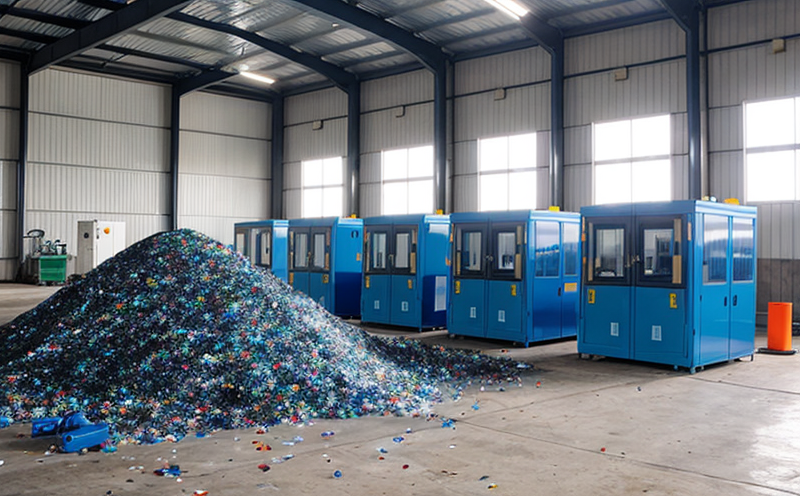ASTM D7855 Rare Earth Element Recovery from Waste Plastics
The ASTM D7855 standard provides a method for recovering rare earth elements (REEs) from waste plastics, specifically targeting the recovery of REEs such as neodymium, praseodymium, and cerium. This service is critical in the rapidly growing sectors of recycling, sustainability, and circular economy initiatives. The demand for REEs is increasing due to their applications in renewable energy technologies, electric vehicles (EVs), and advanced electronics.
The recovery process outlined in ASTM D7855 involves several key steps: sample preparation, dissolution, separation, purification, and quantification of the REEs. Sample preparation typically includes grinding the plastic waste into a fine powder to increase surface area for dissolution. The dissolution step uses specific acids or solvents that are compatible with the plastic matrix without causing degradation.
Once dissolved, the mixture is separated using ion exchange resins or solvent extraction techniques. These methods allow for selective recovery of REEs while minimizing the loss of other valuable materials. The purified solution containing the REEs is then quantified using spectroscopic techniques such as inductively coupled plasma mass spectrometry (ICP-MS) to determine the concentration and purity of each element.
The ASTM D7855 process ensures that recovered REEs meet or exceed the quality standards required for their intended applications. This service is particularly beneficial for companies involved in waste management, recycling, and material recovery operations. By utilizing this method, they can not only reduce environmental impact but also generate additional revenue streams by recovering valuable materials.
The ASTM D7855 process is compatible with various types of plastic waste, including polyethylene terephthalate (PET), high-density polyethylene (HDPE), low-density polyethylene (LDPE), and other mixed plastics. This versatility makes it an essential tool in the recycling industry where diverse waste streams are common.
In addition to its technical advantages, ASTM D7855 also addresses regulatory compliance issues associated with waste management and recycling operations. By adhering to this standard, companies can ensure that their processes meet environmental protection regulations without compromising on efficiency or cost-effectiveness.
A key aspect of the ASTM D7855 process is its adaptability to different scale operations ranging from small-scale pilot plants to large industrial facilities. This flexibility allows businesses to tailor the recovery process according to their specific needs and resources, ensuring optimal performance across all scales of operation.
Another important consideration when implementing ASTM D7855 is the economic viability of the recovered REEs. The market value of these elements can fluctuate significantly depending on global supply-and-demand dynamics. Understanding current market trends helps in making informed decisions about whether to invest in this process and how best to maximize financial returns.
Finally, it's worth noting that while ASTM D7855 focuses primarily on REEs from waste plastics, the principles involved can be extended to other types of industrial byproducts containing valuable metals. This opens up possibilities for further innovation within the broader field of resource recovery and reuse.
Why It Matters
The importance of recovering rare earth elements (REEs) from waste plastics cannot be overstated in today's world where sustainability and circular economy practices are gaining prominence. REEs play a crucial role in numerous high-tech industries, including renewable energy systems like wind turbines and solar panels, electric vehicle batteries, and advanced electronics.
- Environmental Impact: Extracting raw materials directly from the earth has significant environmental consequences. By recovering REEs from waste plastics, we reduce the need for primary extraction methods which are often associated with high levels of pollution and resource depletion.
- Sustainability: Implementing ASTM D7855 helps promote a more sustainable approach to managing waste materials by ensuring that valuable resources aren't lost during the recycling process.
- Economic Benefits: Recovered REEs can be sold at market rates, providing financial incentives for companies engaged in this practice. Additionally, it contributes positively towards reducing operational costs associated with raw material procurement.
In summary, adopting ASTM D7855 aligns perfectly with global efforts aimed at fostering sustainability through improved resource management practices while simultaneously addressing the growing demand for REEs across various sectors.
Why Choose This Test
- Precision: The ASTM D7855 process is highly precise, enabling accurate quantification of REEs in waste plastics. This precision ensures reliable results that can be trusted for regulatory compliance and internal decision-making purposes.
- Versatility: This method works effectively with a wide range of plastic types and grades, making it suitable for diverse operational environments within the recycling industry.
- Cost-Effective: Although initial investment costs may vary depending on scale, long-term savings can be achieved through reduced raw material expenses and increased saleable product yields.
- Eco-Friendly: By recovering valuable materials from waste streams, this process significantly reduces landfill usage and associated environmental impacts. It supports broader efforts towards reducing carbon footprints in manufacturing processes.
The combination of these factors makes ASTM D7855 an attractive choice for businesses looking to enhance their operational efficiency while contributing positively towards sustainability goals.
Competitive Advantage and Market Impact
- Market Differentiation: Companies that adopt the ASTM D7855 process gain a competitive edge by demonstrating commitment to sustainable practices. This can enhance brand reputation among environmentally conscious consumers.
- Innovation Leadership: Early adoption of this technology positions companies as leaders in resource recovery innovation, setting trends for future industry standards.
- Potential Cost Savings: Efficient use of recovered REEs could lead to substantial cost reductions over time, particularly when considering long-term supply chain considerations.
- Regulatory Compliance: Adherence to recognized international standards like ASTM D7855 ensures compliance with relevant environmental regulations worldwide. This reduces legal risks associated with non-compliance issues.
The implementation of ASTM D7855 not only offers immediate benefits but also sets a foundation for continuous improvement in resource management practices, contributing towards long-term success in the recycling and manufacturing industries.





